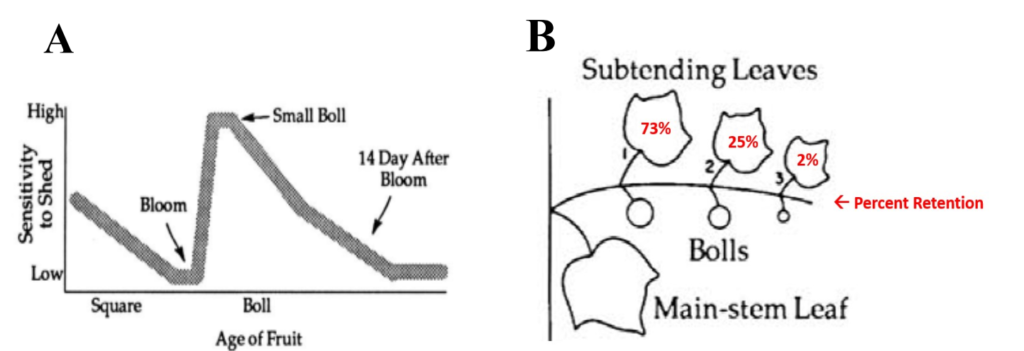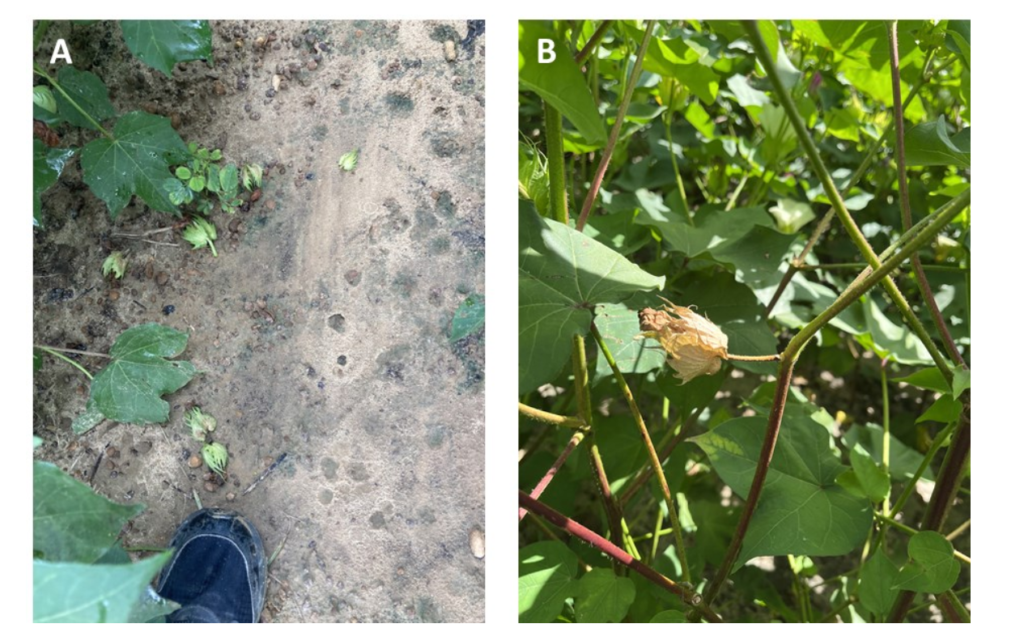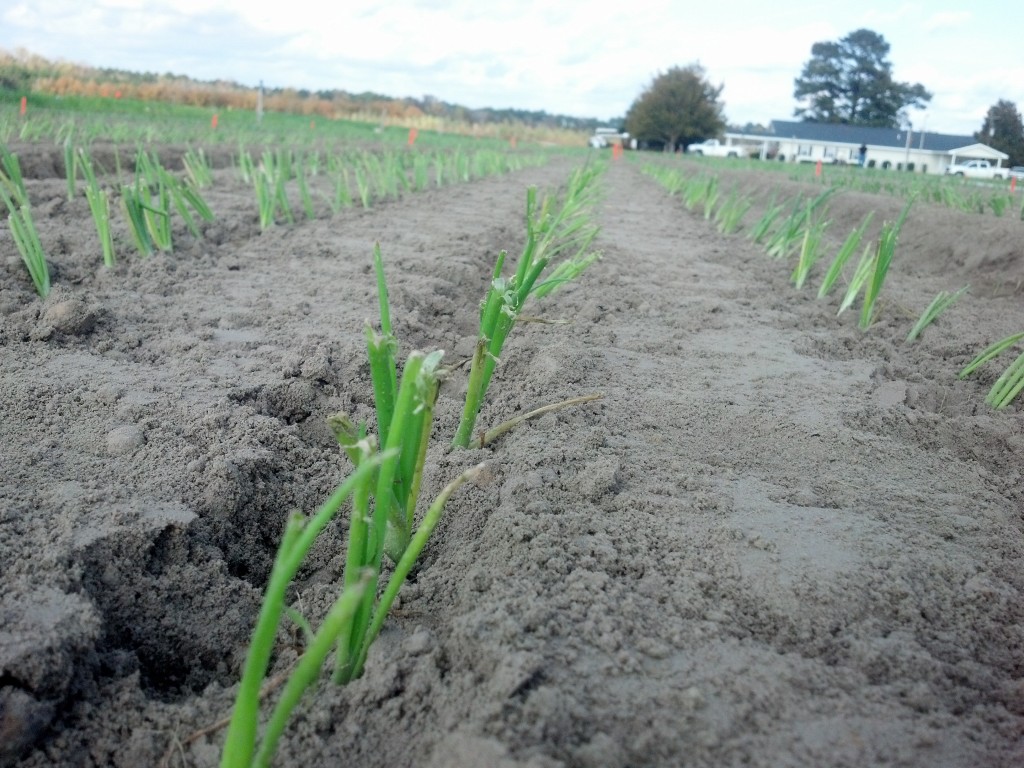I have recently had some calls about boll shed on cotton that has began cutting out. Here is a good article from the August edition of The UGA Cotton newsletter discussing aspects of why this can happen.
In the last newsletter, I discussed the effects of environmental stress on physiological
processes in cotton. I did so because of the high temperature and low rainfall conditions we had experienced up to that point in the season. Consequently, I was convinced we would start to see significant increases in fruit abscission once the crop got into the peak bloom phase of development. We are now in the peak bloom to cutout phase of development for well-managed cotton planted back in May, and to my surprise, the crop seems to have fairly high fruit retention this season, which I’m sure Dr. Hand will mention at some point in this newsletter. Nonetheless, fruit abscission/shed (even at low rates) is observed in every cotton field in the state at one point or another during the season. Various environmental conditions such as extreme heat,drought, excessive rains, cloudy days, and certain management practices conducive to rank growth will promote fruit shed. However, fruit shed may also occur as a consequence of normal intra-plant competition for resources during crop development. The abscission zone is a layer of cells present at the base of the petiole (leaves) or peduncle (fruit stalk) as shown in Figure 1 below. Abscission takes place due to softening and weakening of the cells in this zone because of two main digestive enzymes: pectinase and cellulase.The plant hormone IAA present in high concentrations in a square or boll will inhibit the production of these enzymes. A reduction in IAA levels or a decrease in the ratio of IAA to ABA in the fruit will stimulate ethylene production, which increases the production of these degradative enzymes and promotes the abscission process.

Insects can cause shedding of squares or smaller bolls of all ages because they cause damage to plant tissues,and this stimulates fruit abscission. However, a certain amount of shedding occurs naturally in the absence of biotic stresses. Under normal conditions, the cotton plant will shed approximately 60% of all squares it produces during a typical growing season. The age of the square or boll also determines the probability it will shed. Larger squares, and medium size bolls have higher resistance to environmental and within-plant factors stimulating fruit shed, resulting in higher retention. Once a boll has made it to two weeks after flowering, it is highly unlikely that it will shed. This is because the plant has already invested significant resources into the development of the fruit and because the vascular system develops very thick, fibrous connections to the plant, preventing fruit shed. Fruit/square retention is also influenced by fruiting site position along a fruiting branch with higher fruit retention for fruit produced closest to the main-stem. The squares farther away from the main-stem have a substantially lower probability of being retained. Crop developmental stage also influences fruit abscission. For example, we have already established that young bolls are more likely to shed than older bolls; therefore, the highest abscission rates are observed in the days following peak bloom. This type of fruit shed will happen even under non-stressed conditions. The following graphs illustrate the sensitivity of square or boll shed based on age of fruit (2 A) and position on the plant (2 B).

Environmental factors causing fruit shed: As mentioned previously, various environmental conditions can influence square or boll shed.Light intensity: The impact of high cloud cover (causing low light intensities) on fruit retention has been heavily investigated. Specifically, exposure of young fruit to extremely low light intensity for even a few days can cause nearly all the fruit at that position to shed. Sensitivity to low light decreases significantly with increases in fruit age. For bolls greater than 2 weeks in age, short term low light conditions have no impact on fruit retention.Temperature: High temperatures impact reproductive growth in cotton more than vegetative growth. One of the most common effects of high temperature (day and night) on reproduction in cotton is an increase in pollen sterility. If this results in poor seed set, the likelihood of fruit set is low. High night temperatures A Bcause pollen sterility by affecting a sensitive stage of pollen development that occurs during early square development. For example, Hodges et al. (1993) showed that day/night temperatures in excess of 95/81°F(day/night temperature) substantially increased boll abscission and negatively impacting productivity. High temperatures occurring during flowering and soon thereafter have also been shown to limit fertilization,thereby increasing the probability of fruit shed.Water: Both high and low soil moisture conditions can substantially influence fruit shed or retention. Low moisture conditions such as drought can increase rates of boll abscission by reducing leaf area and photosynthetic efficiency, thereby limiting the number of fruit the crop can support. In contrast, water excess can stimulate rank growth, causing extensive shading of lower branches and high rates of fruit abscission. Additionally, the timing and amount of water received by the crop can affect percent seed stand rate of abscission.Some observations: The first observation worth repeating is that fruit retention has been high this growing season, so I haven’t seen as many young bolls on the ground as I’ve seen in the past (Figure 3A). Secondly,abscission is an enzymatic process, so it needs to occur in living, hydrated tissues. In some instances, when well-maintained cotton plants are exposed to high air temperatures, drought, or both during flowering, water loss from the young fruit exceeds water supply from the plant, and the fruit will get frozen in place(“mummified”). This occurs because the tissue desiccates rapidly, and this prevents the full degradation of the abscission zone (Figure 3B). I haven’t seen this very much during the current growing season, but it does illustrate the need for a properly-formed abscission layer. This will be relevant when we discuss the physiology of defoliation in subsequent newsletters.

